
Having a first aid kit in your car whether you travel for work or pleasure allows you to make a journey with peace of mind that if something were to happen you would have supplies to treat your injuries.
Legal requirements for First Aid Kits in commercial vehicles
If a vehicle is being used for work activities, then it should be treated as though it is covered by the same workplace first aid legislation as any other workplace. Whether the vehicle you are driving is owned by yourself (a grey fleet vehicle) or a company, provisions should be made to ensure you have suitable first aid supplies.If the vehicle is used for travelling abroad, note that the legal requirements will vary depending on the laws of the country. For example, many European drivers are required to always have at least one warning triangle and hi-visibility jackets in the cabins of their vehicles.
First aid requirements that may differ from normal workplace first aid
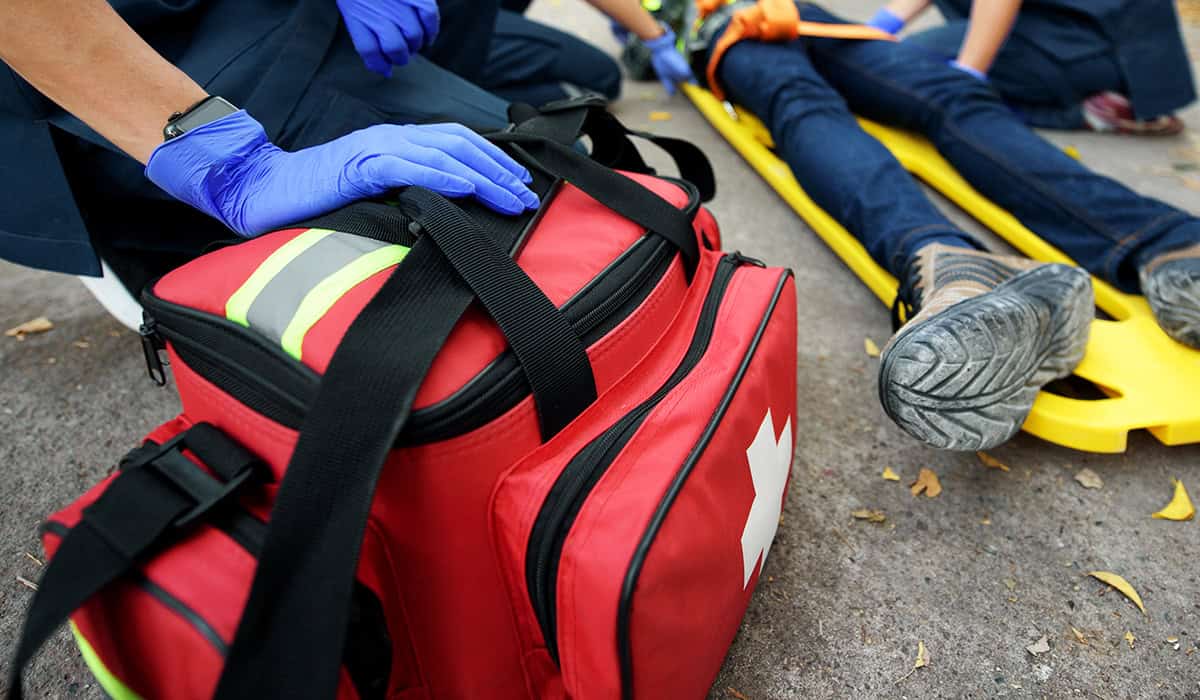
What constitutes as “adequate and appropriate” first aid supplies for the workplace in HSE legislation may look slightly different when considering the hazards someone could come across while driving for work. This is why it is best for employers to complete additional risk assessments for any employees who will be driving in addition to what is required for office based staff.
Drivers may face:
- Fatigue
- Heat stroke
- Stress
- Other drivers behaving recklessly
- Dangerous weather conditions
Essential items for commercial vehicle first aid kits
The essential items that are included in a commercial vehicle’s first aid kit are mostly the same, regardless of the type of vehicle, in terms of which supplies are best. However, the volume will differ depending on the number of passengers. In addition, if the employee is travelling abroad the necessary requirements will vary depending on the laws of the country.Here are some examples of what you may expect to find in the first aid kits of HGVs, vans, cars and buses:
H3 HGVs
Depending on the goods that are being transported, you may find it better to have a first aid kit with a fire extinguisher so that any potential fires are put out quickly and efficiently. In fact, it is a legal requirement for all HGVs to carry a fire extinguisher, the type and weight will differ depending on the cargo and size of the vehicle.Otherwise, the essential items for HGV first aid kits according to the HSE include:
- First aid guidance leaflet
- First aid dressings, 12x12cm
- First aid dressings, 18x18cm
- Triangular bandages
- Safety pins
- Washproof plasters
- Disposable gloves
- Foil blanket
- Eye wash pods
- Sterile moist wipes
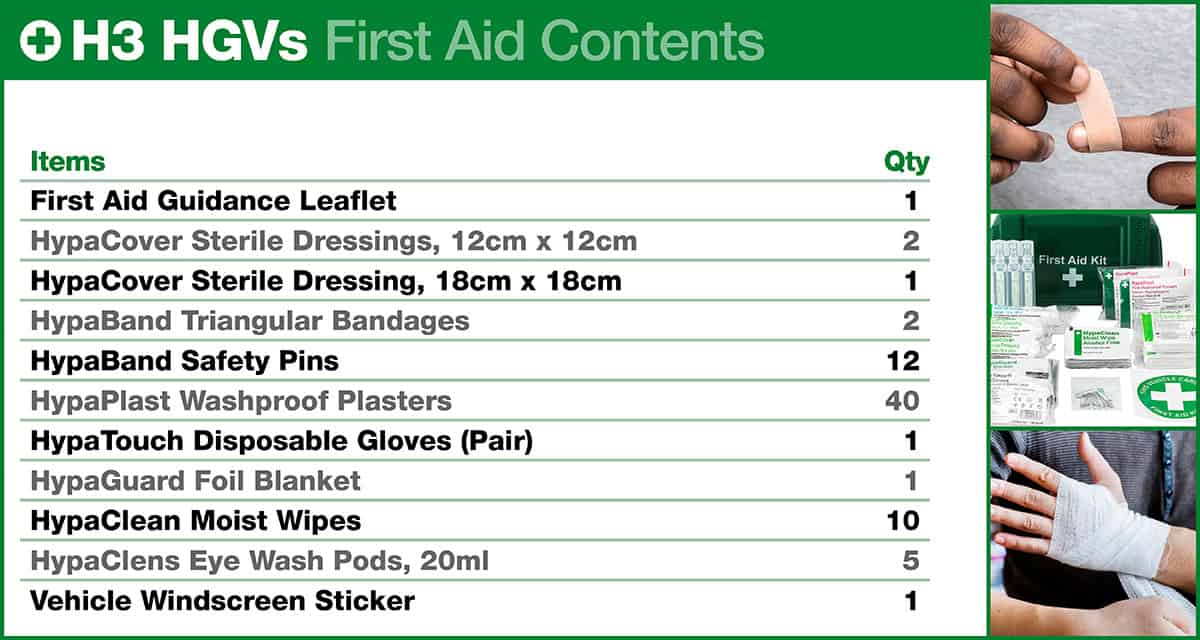
The number of supplies for trucks and other HGVs will tend to be lower than those for cars and buses as there are usually only one or two people travelling via this mode of transport at any one time.
Vans
Commercial vans have very similar requirements to HGVs in their first aid kits as there tend to only be one or two passengers along with cargo when they’re travelling. They are also legally required to have a fire extinguisher on board.There may be a slight discrepancy in the number of supplies carried by each vehicle, but this is our recommendation for a van first aid kit:
- First aid guidance leaflet
- HypaCover Trauma Dressing, Medium
- HypaCover Sterile Dressing, 12x12cm
- HypaBand Triangular Bandage
- HypaCover Adhesive Dressing, 10x8cm
- HypaPlast Washproof plasters
- HypaTouch Nitrile gloves
- HypaGuard Foil blanket
- HypaSoothe Burns Dressings, 10x10cm
- HypaClean Sterile moist wipes
- Clothing Cutters
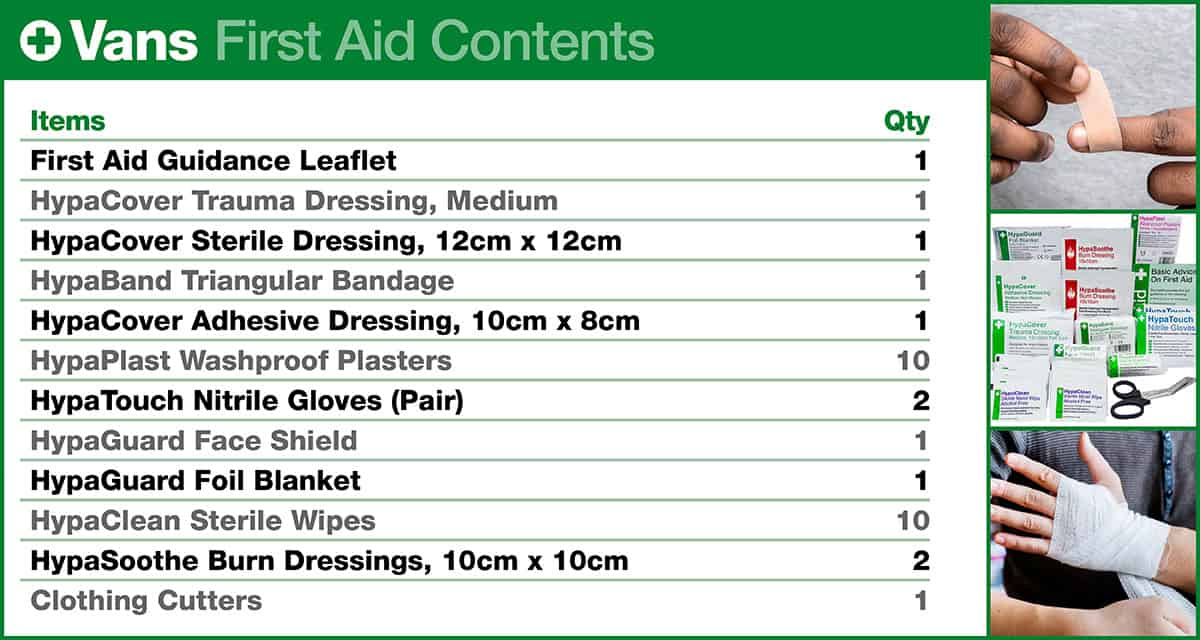
Cars and taxis
Commercial cars and taxis will require smaller cases, something that will easily slide under a seat or into the glove compartment for when it’s needed. If the employee is carrying passengers such as a taxi driver would be, then it is a legal requirement for the car to contain a fire extinguisher.
The essential first aid supplies will remain the same though. This is what you can find in our car and taxi first aid kits:
- First aid guidance leaflet
- HypaCover Trauma Dressing, Medium
- HypaCover Sterile Dressing, 12x12cm
- HypaBand Triangular Bandage
- HypaCover Adhesive Dressing, 10x8cm
- HypaPlast Washproof plasters
- HypaTouch Nitrile gloves
- HypaGuard Face Shield
- HypaGuard Foil blanket
- HypaSoothe Burns Dressings, 10x10cm
- HypaClean Sterile moist wipes
- Clothing Cutters
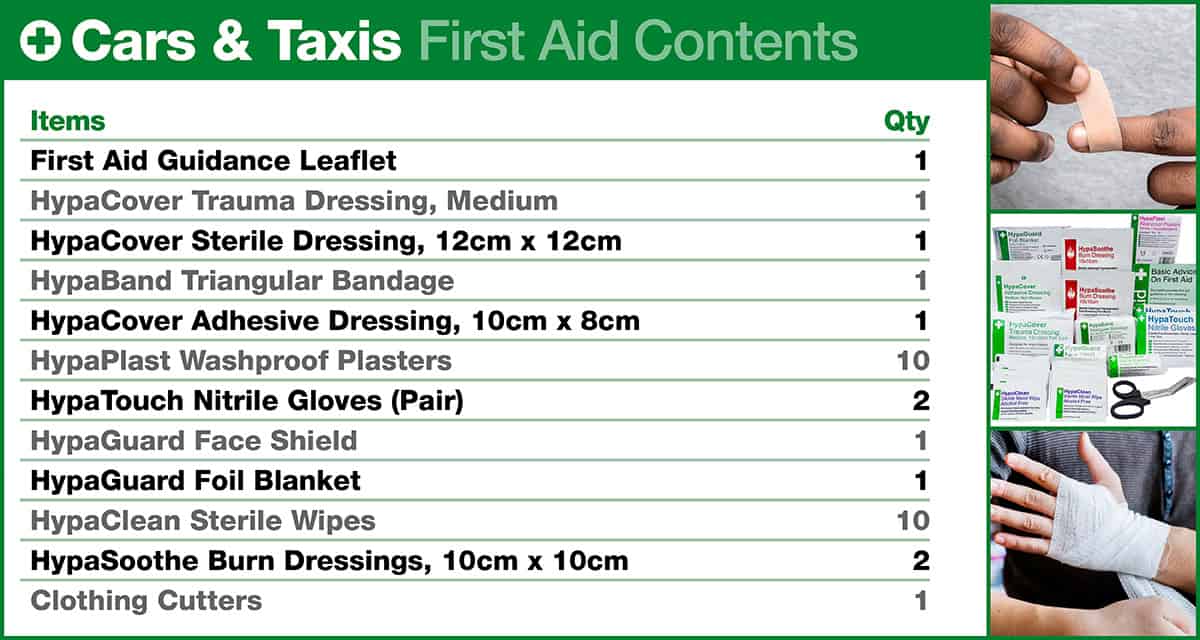
Buses and Minibuses
Buses and minibuses will require a larger number of supplies in their first aid kits compared to the rest of these transport methods due to the number of passengers they will be carrying. As such, it is the employer’s responsibility to maintain a level of care for these passengers and the driver.It is also recommended that there is a smaller first aid kit near the front of the bus and a larger one towards the back so that at least one will be accessible at all times.
This is what you can expect to find in our Minibus and Bus First Aid Kit in Evolution Case:
- First aid guidance leaflet
- HypaCover Trauma Dressing, Medium
- HypaCover Trauma Dressing, Large
- HypaCover Sterile Dressing, 12x12cm
- HypaBand Triangular Bandage
- HypaCover Adhesive Dressing, 10x8cm
- HypaPlast Washproof plasters
- HypaTouch Nitrile gloves
- HypaGuard Face Shield
- HypaGuard Foil blanket
- HypaSoothe Burns Dressings, 10x10cm
- HypaClean Sterile moist wipes
- Clothing Cutters
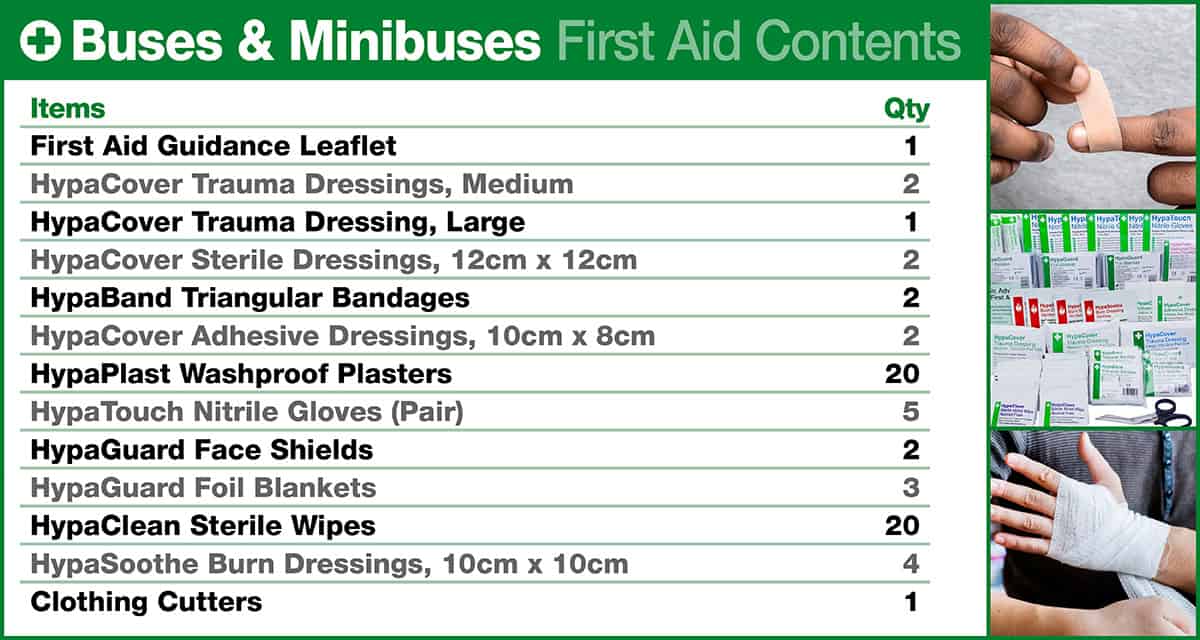
Restocking and maintenance
As with any first aid kits, maintaining the stock levels and condition of any commercial vehicle’s first aid supplies is important.Certain items may go out of date sooner than others, and as a general rule, first aid kits have a shelf life of 3-5 years. The longer the supply has been unused the less effective it becomes, which is why it is recommended that you replace items regularly and check for any damage to the packaging which could spoil the quality.
First aid kits are designed to be used in an emergency, making it important to check that the supplies are restocked and in date so that they can be used if an accident occurs. This is simple to do using either a refill kit or restocking individual items as they are used.
H2 First aid training
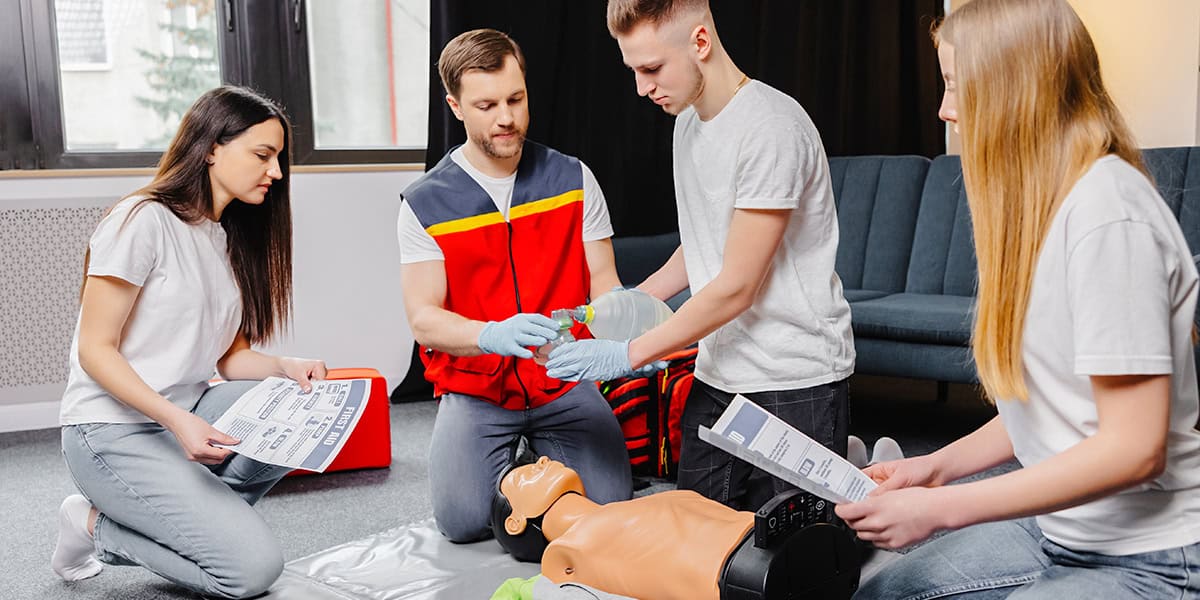
Supplying commercial vehicles with a first aid kit is crucial for the safety of drivers and passengers. However, it is also important that drivers have the skills necessary to use the equipment provided.
For example, they will need to know how to use wound dressings and how to clean a wound if they are going to use the kit effectively in an emergency situation.
As such, employers should invest in first aid training for all employees who will be driving alone or travelling for long stretches of time.
Things to consider for commercial vehicle first aid
Driving on the road, particularly for work can be incredibly dangerous, so having a first aid kit close to hand can be reassuring in case the worst were to happen, particularly if it stocked with plenty of bandages and the materials needed to treat minor injuries and bleeding until emergency services arrive. Remember that different vehicles will require different types of first aid kitIt is also important to consider training for areas such as CPR and treating wounds so that drivers know how to act confidently in those situations where seconds count.
Read our other blogs for more information on first aid or contact us for further advice and information on our products.
By Sarah Mason

